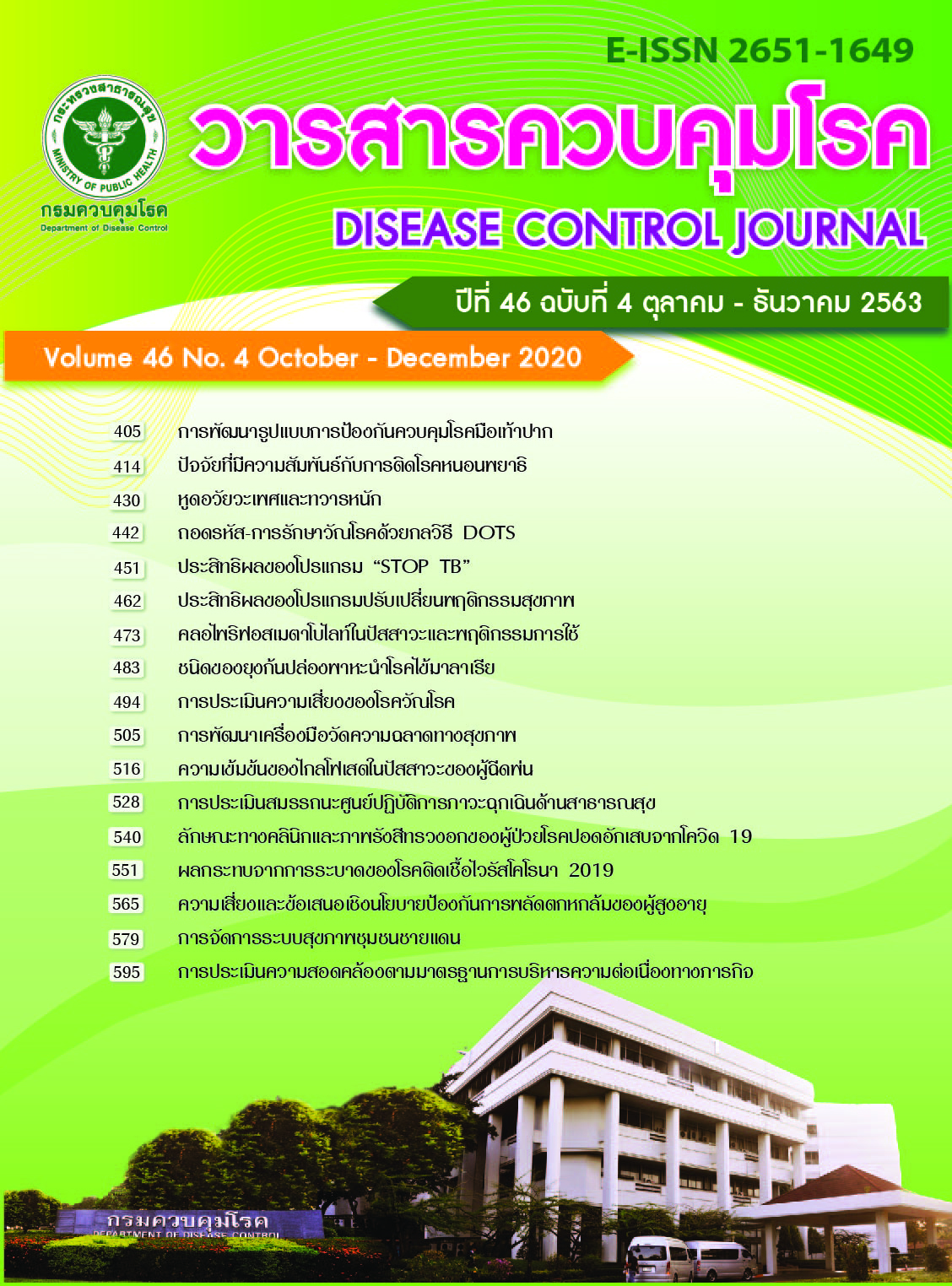The development of health literacy assessment tool for sexually transmitted infection (STI) prevention among vocational school students
DOI:
https://doi.org/10.14456/dcj.2020.47Keywords:
health literacy assessment tools, sexually transmitted infection, vocationalAbstract
This study aimed to develop a health literacy assessment tool for sexually transmitted infection (STI) prevention in vocational students in the Health Region 7 of Thailand. The initial step was to select assessment topics through literature review based on the Nutbeam’s concept. The preliminary tool was comprised of 65 assessment items for male and 60 items for female, which was undergone content analysis by five experts to select the items with the index of item-objective congruence (IOC) over ≥0.5. As a result, the final assessment tool was obtained with 53 items for male and 52 items for female. The proposed tool was validated among sample groups of 100 males and 100 females, and the discrimination power ranging from 0.2-0.8 was observed. In addition, the difficulty score ranged from 0.4-0.9, the Kuder–Richardson Formula 20 score (KR-20) ranged from 0.4-0.6, and Cronbach’s alpha ranged from 0.6 to 0.9. The assessment tool was subsequently utilized in two sample groups of 100 males and 100 females. The confirmatory factor analysis showed that the model was consistent with empirical data with the goodness of fit statistics (for the male tool: 2 = 13.038, df= 6, p=0.161, 2/df = 2.173, RMSE = 0.067, SRMR =0.043, CFI =0.977, TLI = 0.962; and for the female tool: 2 = 10.907, df = 9, p=0.282, 2/df = 1.211, RMSE = 0.046, SRMR = 0.046, CFI = 0.978, TLI = 0.963). The main weights of influence for health literacy included three components: access to information and services, communications skill, and self-management. The cut-off score was 77 points for male and 82 points for female. In conclusion, the assessment tool was found to be useful; and it should be widely used for measuring health literacy in other vocational students.
Downloads
References
Bureau of Epidemiology. The report of surveillance behavior related HIV infection among students, Thailand 2018 [Internet]. Nonthaburi: Department of Disease Control (TH); 2018 [cited 2019 Jan 16] 73 p. Available from: http://www.boe.moph.go.th/aids/Downloads/book/2561/Paper_STU61.pdf (in Thai)
National Disease Surveillance (Report 506) [Internet]. Nonthaburi; Department of Disease Control (TH), Bureau of Epidemiology. Sexually Transmitted Diseases; 2017 [cited 2018 Jul 10]. Available from: http://www.boe.moph.go.th/boedb/surdata/index.php (in Thai)
Wasserheit JN. Epidemiologic synergy. Interrelationships between human immunodeficiency virus infection and other sexually transmitted diseases. Sex Transm Dis. 1992;19(2):61-77.
GNew Blog. Department of Disease Control was suggesting people to use the principle of “SEX carefully, answer OK” to prevent sexually transmitted diseases and AIDS during the month of love this year. Thailand; 2562 [Internet]. [cited 2019 Jun 22]. Available from: https://gnews.apps.go.th/news?news=35745
World Health Organization. Health promoting glossary. Geneva: World Health Organization; 1998.
Nutbeam D. Health literacy as a public health goal: a challenge for contemporary health education and communication strategies into the 21st century. Health Promot Int. 2000;15:259-67.
Health Education Division. Guidelines for health education and health behavior. Nonthaburi: Department of Health Service Support (TH); 2018. (in Thai)
Hair JF, Black WC, Babin B, Anderson RE, Tatham RL. Multivariate data analysis. 6th ed. New Jersey: Prentice Hall; 2005.
Namwong T, Khiewyoo J. Development of the scale for measure perception of HIV risk of men who have sex with men. Journal of Health Science. 2015;24(4):670-8. (in Thai)
Wijitwanna S, Angsuchoti S, Jumongsri S, Pinyopanuwat R, Sirirungpan C. Research for teaching and learning development. Bangkok: Charoen Dee Mankong Printing; 2013. (in Thai)
Pasiphul S. Creating and developing tools for measuring and evaluating education. 2nd ed. Bangkok: Chulalongkorn University; 2011. (in Thai)
Wiratchai N. LISREL Model: statistical analysis for research. 3rd ed. Bangkok: Chulalongkorn University; 1999. (in Thai)
Suksawang P. Structure equation modeling. Bangkok: Walthanapanit; 2013. (in Thai)
Downloads
Published
How to Cite
Issue
Section
License
Articles published in the Disease Control Journal are considered as academic work, research or analysis of the personal opinion of the authors, not the opinion of the Thailand Department of Disease Control or editorial team. The authors must be responsible for their articles.






